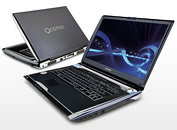- Joined
- Oct 9, 2007
- Messages
- 47,895 (7.38/day)
- Location
- Dublin, Ireland
| System Name | RBMK-1000 |
|---|---|
| Processor | AMD Ryzen 7 5700G |
| Motherboard | Gigabyte B550 AORUS Elite V2 |
| Cooling | DeepCool Gammax L240 V2 |
| Memory | 2x 16GB DDR4-3200 |
| Video Card(s) | Galax RTX 4070 Ti EX |
| Storage | Samsung 990 1TB |
| Display(s) | BenQ 1440p 60 Hz 27-inch |
| Case | Corsair Carbide 100R |
| Audio Device(s) | ASUS SupremeFX S1220A |
| Power Supply | Cooler Master MWE Gold 650W |
| Mouse | ASUS ROG Strix Impact |
| Keyboard | Gamdias Hermes E2 |
| Software | Windows 11 Pro |
Toshiba launched the Qosmio G55-802, the first laptop available with a CELL-design based Co-Processor. The CELL developed jointly by Toshiba, Sony, and IBM comes in a 4-SPE avatar which Toshiba chooses to call Toshiba Quad-Core HD processor. The laptop features a Intel Core 2 Duo Processor P7350 at 2.00 GHz as the primary system processor, certain CPU-intensive tasks such as hardware HD video decode, transcode, etc., are performed by the CELL processor. It also features a NVIDIA GeForce 9600M graphics processor for smooth video playback and exceptional gaming performance. 4 GB of DDR2 800 memory is standard, with the GPU supporting TurboCache for additional video memory. A DVD-SuperMulti (+/-R double layer) with Labelflash (think of it as something similar to LightScribe) drive, 2x 250GB 5400rpm HDDs, and 802.11b/g/n supportive wireless network controller. The chassis features rugged yet stylish matte finish. It tips the scales at 5.4 kg (~ 10.8 lbs), rather heavy. It is priced at US $1549.99. An online brochure can be viewed here. For product details, please visit this page.

View at TechPowerUp Main Site

View at TechPowerUp Main Site





